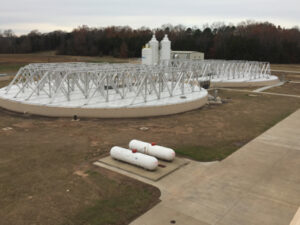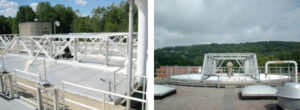Covers and Enclosures for Odor Control: Protecting Your Facility and the Community
 Odor problems can create challenges for any industrial or municipal facility. Strong smells coming from wastewater plants, food processing areas, or composting operations often lead to community complaints. In some cases, they may even draw regulatory attention or require unplanned upgrades. Taking steps to manage these odors before they leave the site is critical for both operations and public relations.
Odor problems can create challenges for any industrial or municipal facility. Strong smells coming from wastewater plants, food processing areas, or composting operations often lead to community complaints. In some cases, they may even draw regulatory attention or require unplanned upgrades. Taking steps to manage these odors before they leave the site is critical for both operations and public relations.
Covers and enclosures provide a practical first step in controlling odor. By containing emissions at the source, these systems reduce how far and how fast odors can spread. They also protect sensitive equipment from weather, which can prevent corrosion and help systems operate more consistently. At Webster Environmental Associates (WEA), we have decades of experience helping facilities identify where covers and enclosures will have the most impact. Our team designs and integrates these systems as part of broader odor control strategies that work in real-world conditions.
How Covers and Enclosures Reduce Odor
The principle behind covers and enclosures for odor control is straightforward: stop odors from escaping before they enter the surrounding air. Physical containment keeps odorous air inside tanks, channels, or buildings, where it can then be directed to a treatment system. Without this first step, even the best odor control technology can struggle to keep up.
Covers can range from partial panels on open tanks to fully enclosed structures with ducting that sends air to biofilters or chemical scrubbers. A partial cover is often enough for tanks or channels that only release low to moderate odors, while high-strength sources usually require a complete enclosure. In addition to capturing odor, these structures protect the process from weather. Rain, wind, or rapid temperature changes can make odors worse; keeping the process stable helps reduce spikes in emissions.
Applications Across Facility Types
Covers and enclosures are versatile and can be adapted to many industries. In wastewater facilities, they are commonly used at headworks, primary clarifiers, and sludge handling areas. These are some of the most frequent sources of hydrogen sulfide and ammonia, which are responsible for strong odors and equipment corrosion.
Industrial facilities also benefit from containment strategies. Food processing operations, chemical plants, and other production sites often release odors during storage, mixing, or material handling. Enclosing these areas not only controls odor but can also improve workplace conditions by reducing employee exposure to strong smells.
Solid waste and composting operations are another area where covers and enclosures play a key role. Decomposing organic material produces noticeable odors that can carry for long distances. Placing covers over compost piles or building enclosures for sorting and handling areas helps reduce the impact on nearby communities.
Design and Integration Considerations
 Designing an effective cover or enclosure requires attention to both function and durability. Material selection is important. Fiberglass-reinforced plastic (FRP), aluminum, and tensioned fabric are common choices. Each material has its advantages depending on weather conditions, chemical exposure, and structural needs.
Designing an effective cover or enclosure requires attention to both function and durability. Material selection is important. Fiberglass-reinforced plastic (FRP), aluminum, and tensioned fabric are common choices. Each material has its advantages depending on weather conditions, chemical exposure, and structural needs.
Access is another key factor. Operators must be able to reach equipment for inspections, cleaning, and maintenance. Adding hatches, removable panels, or doors allows for safe and convenient access without compromising odor containment. In many projects, covers and enclosures are combined with ducting to direct the captured air to treatment systems such as biofilters or chemical scrubbers. This integration creates a complete odor control approach, moving from containment to treatment efficiently.
How WEA Supports Cover and Enclosure Projects
At WEA, we start every project with a detailed site evaluation. This step identifies the main odor sources and determines which areas will benefit most from being covered or enclosed. Once we understand the layout and emission profile, our engineers develop a custom design that balances odor capture, airflow, safety, and long-term maintenance needs.
Our role continues beyond the initial design. We integrate covers and enclosures with odor treatment systems and monitoring equipment when needed. We also provide support during installation and offer guidance on routine inspections to maintain performance. For facilities looking to improve community relations and reduce odor complaints, our goal is to provide practical solutions that work over time, not just on paper.
Protect Your Facility and Community with WEA
Covers and enclosures for odor control are one of the most effective ways to protect both your operation and the surrounding area. They reduce the risk of community complaints, support regulatory compliance, and help maintain a cleaner, safer facility. When combined with treatment technologies, they form a reliable foundation for long-term odor management.
If your facility is facing odor challenges, WEA can help. Our team provides evaluations, design, and integration services tailored to your site. Contact us to schedule a consultation and learn how covers and enclosures can strengthen your odor control program while supporting community trust.
